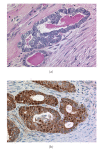Molecular abnormalities in ovarian cancer subtypes other than high-grade serous carcinoma
- PMID: 20069115
- PMCID: PMC2804051
- DOI: 10.1155/2010/740968
Molecular abnormalities in ovarian cancer subtypes other than high-grade serous carcinoma
Abstract
Ovarian cancer is the fifth leading cause of cancer death in women in North America, and approximately two-thirds of cases of ovarian cancer are of high-grade serous type. The remaining cases are comprised of a mix of different tumor types (e.g., endometrioid, clear cell, mucinous, etc.), with no single tumor type accounting for more than 10% of ovarian cancer cases. These tumor types can be reproducibly diagnosed, and each features distinct underlying molecular events during oncogenesis, with a characteristic natural history and response rate to conventional cytotoxic chemotherapy. In this review the molecular abnormalities present in the more common non-high-grade serous subtypes of ovarian cancer will be presented. Development of targeted therapies for these tumor types will require understanding of the genetic basis of each tumor type, and may lead to subtype-specific therapy.
Figures



References
-
- Tavassoli FA, Devilee P, editors. World Health Organization Classification of Tumors: Pathology and Genetics. Tumours of the Breast and Female Genital Organs. Lyon, France: IARC Press; 2003.
-
- Gilks CB, Prat J. Ovarian carcinoma pathology and genetics: recent advances. Human Pathology. 2009;40(9):1213–1223. - PubMed
-
- Köbel M, Kalloger S, Huntsman DG, et al. Differences in tumor type in low versus high stage ovarian carcinomas. submitted. - PubMed
-
- Köbel M, Hunstman DG, Gilks CB. Critical molecular abnormalities in high-grade serous carcinoma of the ovary. Expert Reviews in Molecular Medicine. 2008;10(e22) - PubMed
LinkOut - more resources
Full Text Sources

